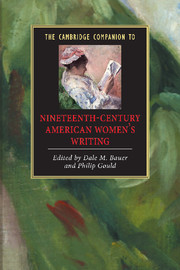Book contents
- Frontmatter
- Introduction
- Part I Historical and theoretical background
- Part 2 Genre, tradition, and innovation
- Part 3 Case studies
- 9 The uses of writing in Margaret Bayard Smith's new nation
- 10 The sentimental novel
- 11 African-American women's spiritual narratives
- 12 The postbellum reform writings of Rebecca Harding Davis and Elizabeth Stuart Phelps
- 13 "Strenuous Artistry": Elizabeth Stoddard’s The Morgesons
- 14 Minnie's Sacrifice: Frances Ellen Watkins Harper’s narrative of citizenship
- Conclusion
- Index
10 - The sentimental novel
from Part 3 - Case studies
Published online by Cambridge University Press: 28 May 2006
- Frontmatter
- Introduction
- Part I Historical and theoretical background
- Part 2 Genre, tradition, and innovation
- Part 3 Case studies
- 9 The uses of writing in Margaret Bayard Smith's new nation
- 10 The sentimental novel
- 11 African-American women's spiritual narratives
- 12 The postbellum reform writings of Rebecca Harding Davis and Elizabeth Stuart Phelps
- 13 "Strenuous Artistry": Elizabeth Stoddard’s The Morgesons
- 14 Minnie's Sacrifice: Frances Ellen Watkins Harper’s narrative of citizenship
- Conclusion
- Index
Summary
When Rose Terry Cooke ended her 1884 biographical sketch of Harriet Beecher Stowe calling her “America's greatest woman,” many readers might still have agreed with her. Memories of Uncle Tom's Cabin, as well as the nearly forty other books and hundreds of articles Stowe produced during her long career, had not gone, though Stowe had largely stopped publishing after her last novel, Poganuc People (1878). Nor did those memories ever entirely die. Dramatic adaptations of Uncle Tom's Cabin appeared continuously on the American stage until at least the 1930s, and the 1920s saw critics Constance Rourke and Vernon Parrington noting her importance in American literary history. From then on, Stowe has been gradually taking her place among the nineteenth-century authors who seem most worthy of study.
Particularly as the New Criticism gave way to reader-response criticism, feminist literary criticism, Marxist criticism, and cultural studies, Stowe became a natural choice for critics seeking interesting paradigms to study. Uncle Tom’s Cabin (1852), probably the best-selling book of the century and certainly internationally famous, is a historical phenomenon impossible to ignore; its interpretation has ranged from protests against its racial stereotyping to admiration for its millennial evangelical feminism and its Balzacian scope.
- Type
- Chapter
- Information
- Publisher: Cambridge University PressPrint publication year: 2001
- 3
- Cited by

